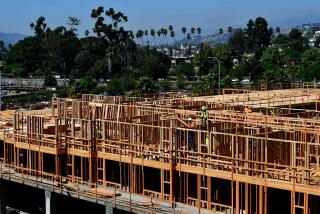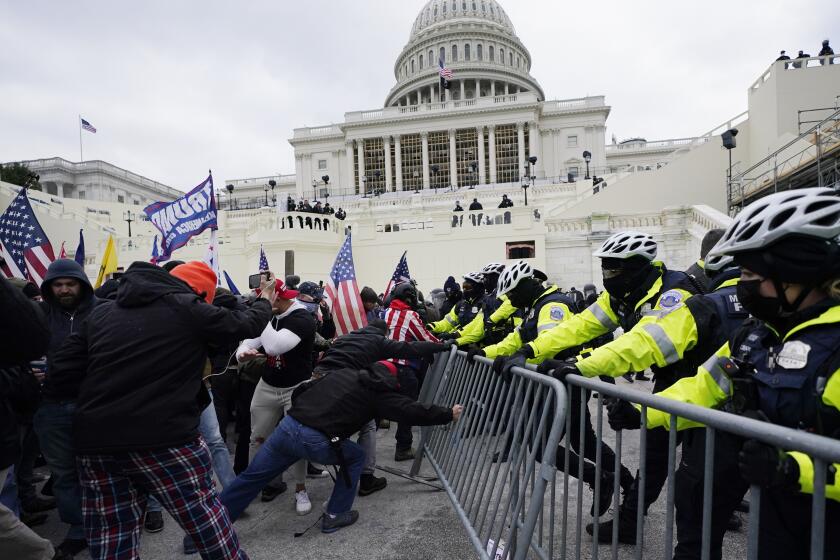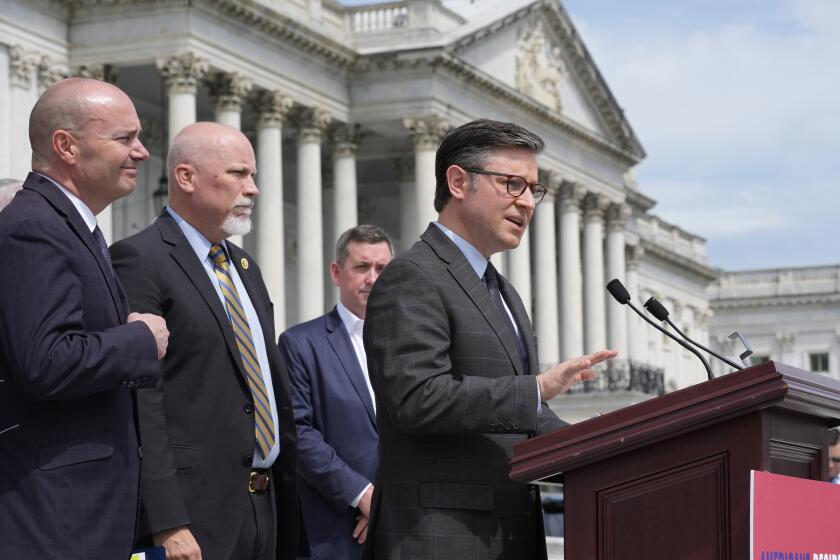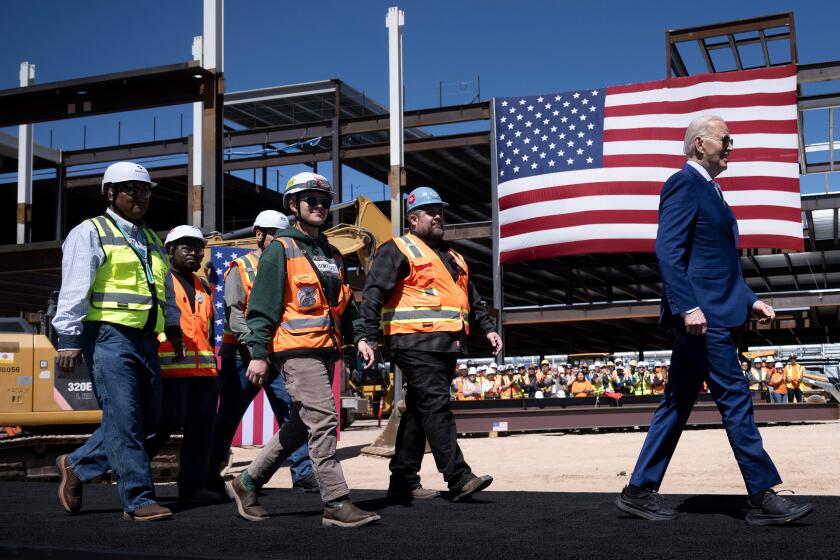Soviet Miners Who Helped Spur Reform Movement Find Life Still Harsh : Labor: After winning pay raises, they see prices shoot up. Working conditions remain bad.
More than 1,500 feet beneath the earth’s surface, Nikolai Medvedev paused in his labor at the seam of glistening coal, and a sardonic smile flashed briefly in the dim light of his miner’s helmet.
“Things are not better than they were before,” Medvedev said in answer to a reporter’s question. “As you can see, I’m still working in this awful place, and there’s no food at home. It’s the same as always.”
More than half a year ago, miners were propelled into the vanguard of the Soviet Union’s fledgling democratic movement by staging a crippling two-month strike in the key coal regions of Donetsk in the Ukraine and here in the Kuzbass, in central Siberia.
Championing the cause of Russian Federation President Boris N. Yeltsin against conservative forces at a key juncture, the miners won promises of improved wages, living conditions and safety standards at their antiquated mines when the strike was over.
But Soviet coal miners still confront a chilling statistic: Their average life expectancy is only 48 years.
And among rank-and-file miners at the Abashavskaya mine here, there is a feeling of a profound letdown months after the strike.
One sign of disenchantment is the fact that only 180 miners out of the 2,200 here have joined the newly formed Independent Union of Mine Workers, which some political analysts once predicted could play a political role in the Soviet Union similar to that of the Solidarity trade union in Poland.
“I’m not joining this union until they show me some results,” said Oleg Agonsov, a third-generation miner at the Abashavskaya complex.
Union leaders counter that they will not press recruitment among the miners until they have a chance to explain their political agenda, but clearly the poor economic situation in the country has cast a pall over the union’s future.
After the strike last March and April, the miners did win a substantial pay raise. From the pre-strike average of 600 rubles a month, the miners now receive an average of 2,200 rubles a month, more than five times the average Soviet pay. (At the commercial rate of exchange, a ruble is worth about 60 cents, but its real value is closer to the market rate of 3 cents.)
But the Soviet economy played a cruel hoax on the miners. Almost as soon as their pay increased, local prices for food shot up as well, in part because there were so many miners in the area with a fatter paycheck.
“My salary increased four times, and the cost of food went up 10 times,” said Yuri Chernov, a union activist.
Miners said that for a short time after the strike, more consumer goods were made available in this grim industrial region of iron foundries and aluminum smelters. But the goods soon ran out and were not replaced.
Despite government promises to improve working conditions for the miners, nothing has been done. According to Vladimir Lavrik, the director, the Abashavskaya complex, built in 1943, is so inefficient that last year it lost 3.5 million rubles, about $2.1 million at the commercial exchange rate.
Not all that long ago, a miner was killed when he was hit by a wagon carrying coal. At the coal face, pieces of felled trees are used to support the roof of the mine shaft, and miners toil in deep pools of freezing coal slurry and air filled with coal dust.
“The working situation is the same as before,” Lavrik said. “We receive payment according to a state price, and there is no room for making improvements or buying modern equipment.”
The inefficiency of Soviet mines contrasts sharply with those in the United States, where there are only 5% as many miners as in the Soviet Union but 20% more coal is produced.
Sergei Kholkov, the head of the Independent Mine Workers Union at Abashavskaya, said a lot of younger miners are moving to other mining regions where they can receive consumer goods directly instead of pay--a growing practice among some Soviet businesses because of the drop in the ruble’s value.
Despite the failure of the strike to achieve major improvements in their living standards, the miners remain staunchly supportive of Yeltsin’s efforts at democratic reforms. According to legend here, Yeltsin’s first words after the start of the unsuccessful coup by Communist Party hard-liners in August were, “The miners are with us.”
“We have our freedom, and we have our president in Boris Yeltsin,” Kholkov said. “It’s obvious that to have economic changes, you have to have political changes.”
Yuri Komarov, a radical miner, won election this year as a deputy in the Novokuznetsk regional Parliament and is one of the co-chairmen of the city’s influential Committee of Workers.
“People said our strike in 1989 started the revolution in Eastern Europe, and the spring strike made the Russian revolution happen,” said Komarov, who wears his arm in a sling after being beaten by Soviet police. “We are still fighting to change the system. People’s attitudes have changed a lot.”
The miners were able to exert political influence by threatening the economic lifeblood of the country. But even union leaders are increasingly doubtful that the same weapon could be deployed in the future.
“Economic conditions are even harder than before,” said Yuri Sarik, an organizer for the new miners union. “It’s going to be very hard to get the men to go on strike again. They cannot afford to lose the money.”
At the moment, the new union has achieved a working relationship both with the administration of the mine and with the old, state-run Trade Union for Miners.
But relations could seriously deteriorate if the mine is forced to start working on a profit-making basis. According to mine officials, more than 1,000 miners could be thrown out of work as inefficient coal faces are closed. Lavrik, the mine’s director, said he does not consider himself a representative of the mine’s owner but one of the workers. Nonetheless, he is prepared to make layoffs if it becomes necessary.
“Our life has changed totally in the last year,” Lavrik said. “The political system is completely different, and even our state of mind has been turned upside down. We don’t believe in tomorrow anymore.”
FACTS ON SOVIET MINERS
* Average life expectancy: 48
* Average wage: 2,200 rubles a month, more than five times the average Soviet pay.
* Productivity: Poor compared to American mines, which produce 20% more coal using just 5% as many miners.
More to Read
Start your day right
Sign up for Essential California for news, features and recommendations from the L.A. Times and beyond in your inbox six days a week.
You may occasionally receive promotional content from the Los Angeles Times.






